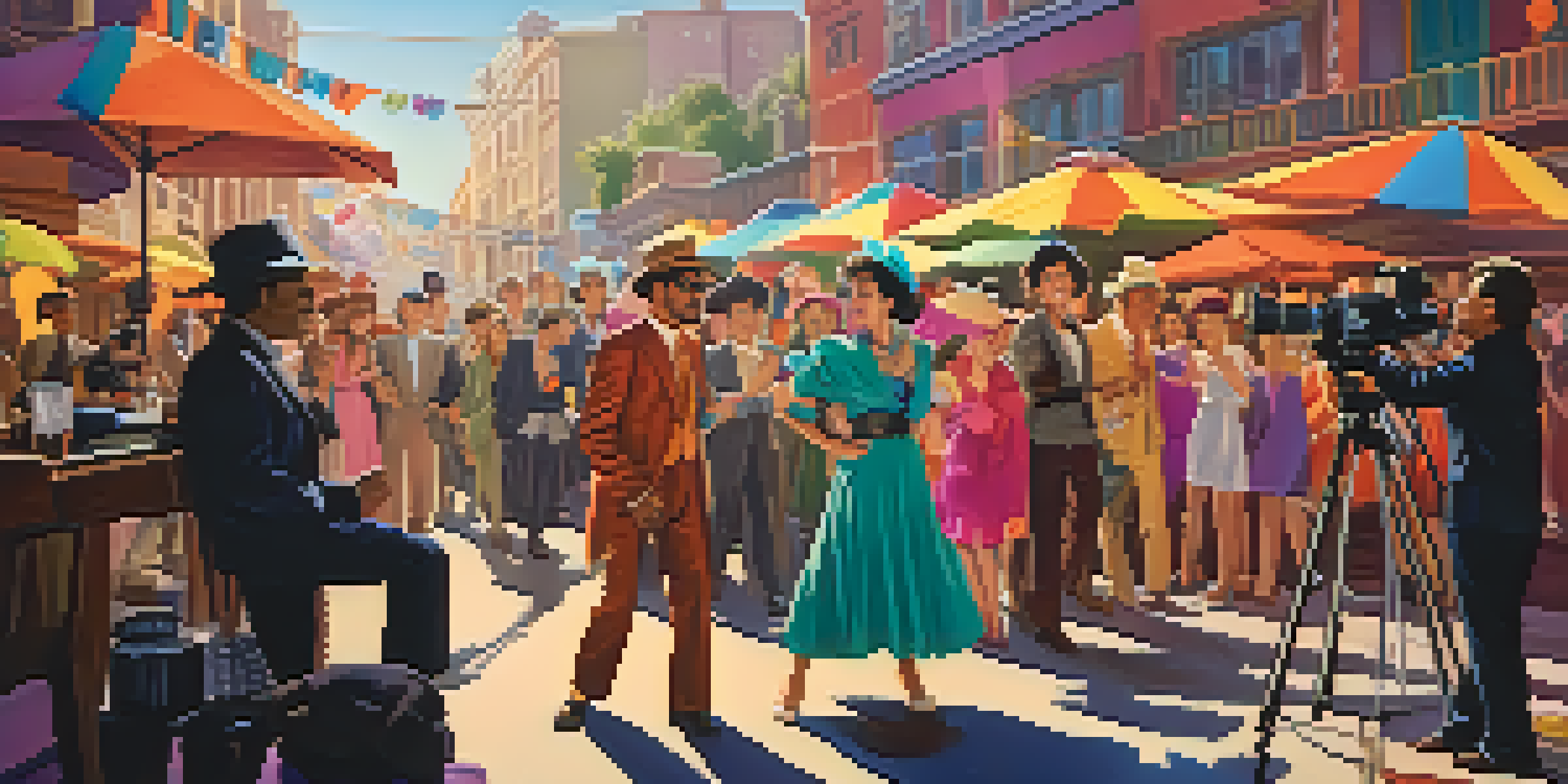The Power of Satire: Comedy Films as Tools for Protest

Understanding Satire and Its Impact
Satire is a clever way of using humor to critique or mock societal issues. Think of it as holding up a mirror to society, showing us our flaws in a way that's both funny and thought-provoking. Through exaggeration and irony, satire reveals truths that might otherwise go unnoticed, allowing audiences to reflect on serious topics without feeling overwhelmed.
Satire is a sort of glass, wherein beholders do generally discover everybody's face but their own.
In comedy films, satire can take many forms, from witty dialogue to absurd situations that highlight real-world problems. This genre encourages viewers to laugh while simultaneously questioning the status quo. By making light of heavy subjects, these films invite audiences to engage with difficult conversations in a more approachable manner.
Examples like 'Dr. Strangelove' or 'The Great Dictator' showcase how satire effectively critiques political power and war. These films illustrate that laughter can be a powerful weapon against oppressive systems, encouraging viewers to reconsider their perspectives on authority and social norms.
Historical Context: Satire in Film
The roots of satire in film can be traced back to early cinema, where comedic shorts often poked fun at societal norms. Over the decades, filmmakers have skillfully woven satire into narratives that resonate with audiences, reflecting the political landscape of their times. Comedy films have consistently provided a platform for dissenting voices, challenging viewers to think critically about current events.

During the 1960s and 70s, films like 'M*A*S*H' and 'Catch-22' emerged as significant examples of using comedy to address the absurdities of war and bureaucracy. These films resonated with audiences who were grappling with societal upheaval, demonstrating how humor can be a catalyst for change. This trend has continued, with modern films often tackling issues like racism, inequality, and environmental concerns through satirical lenses.
Satire Uses Humor for Critique
Satire cleverly employs humor to reflect societal flaws, encouraging audiences to engage with serious issues in a light-hearted manner.
As the landscape of filmmaking evolves, the role of satire remains crucial in shaping public discourse. Comedy films serve as a reminder that laughter can coexist with serious commentary, allowing filmmakers to address challenging topics while engaging viewers in a meaningful way.
Modern Examples of Satirical Comedy
Recent comedy films like 'The Death of Stalin' and 'Get Out' illustrate the power of satire in addressing contemporary issues. In 'The Death of Stalin,' the absurdity of political power struggles is laid bare, prompting viewers to reflect on the nature of authority. Similarly, 'Get Out' cleverly uses horror and humor to tackle themes of racism and cultural appropriation, proving that satire can cross genres to expose uncomfortable truths.
The duty of a comedian is to make us laugh, at the same time as he has us thinking.
Shows like 'The Daily Show' and 'Saturday Night Live' also play pivotal roles in this satirical landscape, using sketch comedy and news satire to comment on current events. These platforms have become essential for engaging audiences in political discourse, often prompting discussions that extend beyond the screen. By blending humor with current affairs, these programs stimulate critical thinking about societal issues.
These modern examples highlight the ongoing relevance of satire in film and television. They remind us that comedy is not just about entertainment; it's a powerful medium for activism and social commentary that can inspire change.
The Role of Audience Engagement
Audience engagement is a crucial aspect of how satire functions in comedy films. When viewers laugh at a joke that critiques societal norms, they become participants in the conversation rather than passive observers. This engagement creates a shared experience that can foster empathy and understanding, making it easier to address complex issues together.
Films that successfully engage their audience often encourage viewers to reflect on their own beliefs and actions. For instance, a well-crafted satirical scene can prompt individuals to question their complicity in societal injustices, leading to personal growth and a desire for change. This interaction between film and audience underscores the potential of comedy as a tool for protest.
Engagement Sparks Societal Change
Audience engagement with satirical films fosters empathy and critical reflection, promoting personal growth and a desire for social change.
Moreover, social media has amplified audience engagement by allowing viewers to discuss and share their reactions to satirical content. This interconnectedness creates a dynamic dialogue around the themes presented in these films, reinforcing the idea that comedy can spark meaningful conversations and inspire activism.
Cultural Reflection and Satire
Comedy films often serve as cultural barometers, reflecting societal attitudes and values. By exaggerating certain aspects of culture, satire can highlight the absurdities and contradictions inherent in social norms. This reflection not only entertains but also encourages viewers to critically examine their own cultural beliefs and practices.
Take, for example, films like 'Borat' or 'Bridesmaids,' which both use humor to critique cultural stereotypes and expectations. These films reveal the often ridiculous nature of societal norms, challenging audiences to reconsider their perceptions of race, gender, and class. By presenting these topics through a comedic lens, filmmakers can make difficult conversations more accessible.
Ultimately, the cultural reflection provided by satirical comedy films allows for a deeper understanding of the world around us. It encourages audiences to question their own roles within society and consider the impact of their actions on others.
Satire as a Form of Protest
Satire functions as a powerful form of protest, giving voice to marginalized perspectives. Through humor, filmmakers can address issues that might otherwise be silenced, shedding light on injustices and sparking conversations that prompt social change. This blend of comedy and critique has become increasingly relevant in today's polarized climate.
Films like 'The Interview' and 'Four Lions' exemplify how satire can challenge political ideologies and provoke thought about sensitive topics. By using humor to tackle terrorism and censorship, these films create a space for dialogue that might be too uncomfortable in a more serious context. This ability to engage with challenging subjects through laughter is a hallmark of effective satirical protest.
Satire as Protest in Modern Media
Through humor, satire serves as a powerful form of protest, addressing marginalized perspectives and fostering dialogue about sensitive topics.
Moreover, as audiences become more aware of social injustices, the demand for satirical content that addresses these issues has grown. Filmmakers are responding by using comedy as a tool for activism, encouraging viewers to take action in their own lives and communities. This evolution of satire reflects its enduring power as a means of protest.
The Future of Satirical Comedy
As society continues to evolve, so too will the landscape of satirical comedy. With the rise of digital platforms, filmmakers have new opportunities to reach audiences and push the boundaries of satire. This accessibility allows for a wider range of voices and perspectives, enriching the genre and enhancing its potential for social commentary.
Looking ahead, we can expect to see more diverse narratives in satirical films, reflecting the multifaceted nature of contemporary issues. These narratives will likely challenge traditional norms and offer fresh perspectives on societal problems. As audiences become more engaged and demanding of thought-provoking content, satirical comedy will continue to adapt and thrive.

Ultimately, the future of satirical comedy holds immense promise for fostering social awareness and inspiring change. By encouraging laughter while addressing serious issues, filmmakers can create a lasting impact that resonates with audiences for years to come.